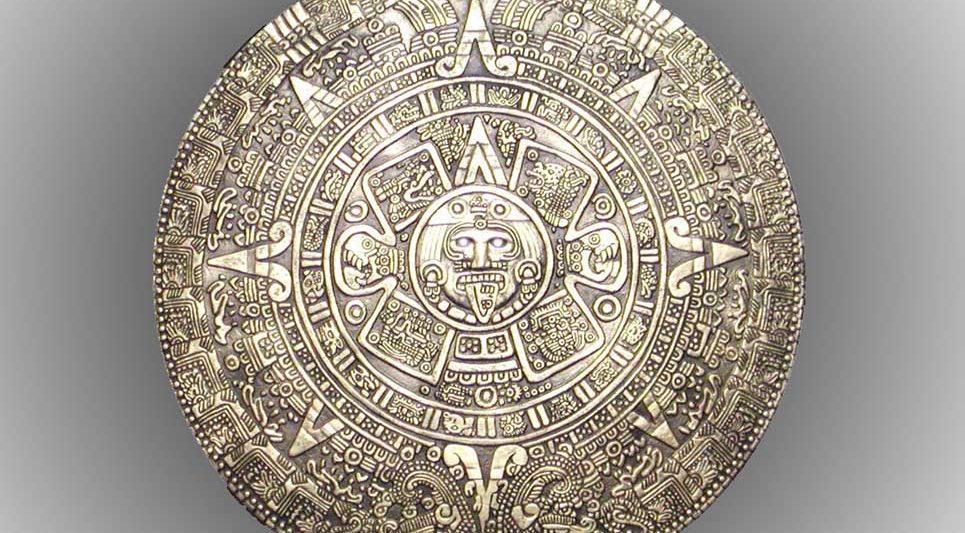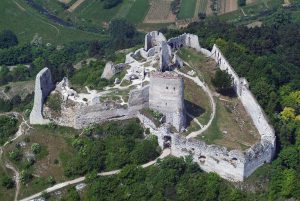Today, when most people think of the Ancient Maya, the first connection that is often made is to their intricate calendar system. What most do not know about the Mayan calendar, however, is that there are three of them. These calendars are the secular or political astronomical calendar, the religious or ceremonial calendar, and the long calendar. The secular astronomical calendar, the Haab, is the Mayan calendar most nearly aligned with our modern conventions (the Gregorian Calendar), since it is based upon a cycle of 365 earth days, while the religious calendar, the Tzolk’in, is 260 earth days; and lastly, there is the long count calendar, which cycles every 5,124 cycles of the Haab.1
Like our modern calendar, the secular, or the Haab, calendar is split into three units of measure. The first and smallest measure on the calendar is the k’in, or the day; next is the winal, which closely aligns with the modern conception of months; finally, there is the Haab, or the entire collective calendar year. There are 20 k’in in the winal, and 18 winal in the haab. There are only five days in the 19th winal, constructing a year nearly equivalent to our modernized Gregorian calendar of 365 days. However, the Mayan Haab did not contain the modern convention of weeks or leap years; each of the twenty k’in (days) in the winal (month) had individual names assigned to them.2
While the Mayan Haab calendar was quite accurate to the duration of one earth year, the methods by which the year was calculated were actually quite primitive. By observation, ancient observers of the sky would mark the positions of heavenly bodies with two staves stuck into the ground. The observers were then able to mark and measure the cycles by the time the measured star or planet took to return to its origin. Gradually, over time, temples were built around these staves, forming what appear to be permanent observatories for certain heavenly bodies. For example, at Tikal, one may stand at the top of the Lost World Pyramid and observe the alignment of three seasons with the points of three pyramids in the course of one year.3

The religious calendar, the Tzolk’in, is a cycle that runs independent of the Haab and Long Count calendars. The Tzolk’in consists of thirteen numbered days interlocked with twenty named days that bear the names of Mayan gods.4 In other words, there are no constructions of weeks, or months in the Tzolk’in; since twenty is not evenly divisible by the thirteen numbered days, the names and numbers of the Tzolk’in do not cycle through evenly. Just as Tuesday will not always fall on the 2nd of the month in the modern Gregorian Calendar, the second numbered day will not consistently align with any certain named day of the Tzolk’in. The Tzolk’in has no certain correlation to astronomy, but it is often thought that it was constructed to reflect the birthing cycle, or perhaps even the seasonal growth of corn.5
The Haab and the Tzolk’in both have their origin in the winter solstice. However, because the Tzolk’in is not evenly divisible into three hundred and sixty-five days, it takes fifty-two years for the Haab and the Tzolk’in to meet again on the winter solstice. This period of fifty-two years is a source of tradition and meaning in Mayan cultures, and it is only when one reached fifty-two years of age that they were thought to be an elder.6
Finally, the Mayan Long Calendar was kept to track the number of days since the Mayan creation date, which was marked as August 11th, 3114 BCE in Mayan creation narratives. The Long Count could be considered to serve the same function as our convention of “A.D.” or “B.C.” It served as the “zero” point from which we are able to count upwards, to provide a linear notion of time. The Long Count calendar takes a format similar to that of the Haab, but is written strictly in numerical format, without any named days or months. The smallest unit of measurement was the Mayan day, or K’in; next came the Winal, which is constructed of 20 k’in; the Tun, which is constructed by 18 Winal; the K’atun, which is the equivalent of 20 Tun; and finally, the Bak’tun, which is the equivalent of 20 K’atun. The notation for the Long Calendar was represented by a format such as 12.19.15.17.7, followed by the present number and day name of the Tzolk’in cycle as well as the number and day name of the Haab cycle. Thus, the full expression of a date would appear something like “12.19.15.17.7 | 7 Manik 10 K’ank’n”, with “Manik” and “K’ank’n” representing the day names of the Tzolk’n and the Haab, respectiviely. 7
- J. Gordon Melton, “Mayan Calendar,” Religions of the World Vol. 4 2nd ed. J. Gordon Melton and Martin Baumann (2010 ABC-CLIO, LLC): 1838-1839. ↵
- J. Gordon Melton, “Mayan Calendar,” Religions of the World, Vol. 4 2nd ed. J. Gordon Melton and Martin Baumann (2010 ABC-CLIO, LLC): 1838-1839; Mark Van Stone, “The Maya Long Count Calendar: An Introduction,” Archaeoastronomy 24 (June 2011): 8–11. ↵
- Charles George and Linda George, “Greatest Achievements,” Maya Civilization, ed. Charles George and Linda George (Lucent Books, 2010), 59-61. ↵
- Mark Van Stone, “The Maya Long Count Calendar: An Introduction,” Archaeoastronomy 24 (June 2011): 8–11. ↵
- George and George, “Greatest Achievements,” Maya Civilization, 59-61. ↵
- J. Gordon Melton, “Mayan Calendar,” Religions of the World, Vol. 4 2nd ed. J. Gordon Melton and Martin Baumann (2010 ABC-CLIO, LLC), 1838-1839. ↵
- Mark Van Stone, “The Maya Long Count Calendar: An Introduction,” Archaeoastronomy 24 (June 2011): 8–11. ↵



22 comments
Aaron Jaramillo
Very well written article! There is a lot of information in it and you organized it very well. I was aware that there was 3 different calendars but unaware what each one meant. I enjoyed reading your article and I’m sure others learned a thing or two from it. Good job.
Mariana Sandoval
I’ve seen many renditions of the Mayan calendar, but I never knew what any of the stuff on it meant or how they spread out their year, etc. This was really informative in that sense. I liked how you clarified between the three different calendars that they used. Good job!
Maalik Stansbury
I like how it explained about teh Mayan culture. I only know like a brief of it and of Mexico, even though Texas is so close to Mexico. I thought you did an excellent job with the explanation and description of the Haab calendar. I thought that was cool. I can’t wait for other people to find out more about the Haab as well.
Andres Palacios
Very interesting, I didn’t know that there were three calendars. Also it was very interesting how they built their temples around these staves that were marked by the observers and the influence of the Haab calendar in this process.
Jezel Luna
When thinking about the Mayan Calendar, something that has always remained in my mind is the “apocalypse” from 2012. However, I was unaware how many different calendars the Mayan had. I like how each of them had a different purpose but tied altogether. This article was very detailed and informative, great work!
Celina Resendez
There is a lot of information in your article and I feel it does a great job of explaining the Mayan calendar. I was aware there were three different calendars, but I was not aware of the function of each. It’s interesting how they all have different functions but all come together in the end.
Kassandra Guillen
This is a very interesting and informative article. I had always heard the Mayan calendar referred to many times ,but never knew any back story to it. I was unaware of the three Mayan Calendars.
Aylin Salinas
Wow, this was a very interesting article about the Mayan calendar. I did not know that there were in fact three calendars and not simply one. As primitive as you may think the calendar is I found it quite confusing in the sense of reading it – of course they may think the same of our calendars. This article was very informative and well researched. I look forward to reading more of your articles!
Meghann Peace
This is a well-written article about a truly impressive feat – the Mayan calendar. I remember the “apocalypse” from 2012. It looks like that would have been the year that the long count calendar’s cycle ended – is that correct? I’ve been rereading the bit on the long count date notation, which is fascinating. Does the count start with the k’in and go to the bak’tun, or vice versa?
Christopher Repka
Meghann Peace,
Yes, the approximated date for the long count calendar’s end was in 2012. Scholars differ about which date that actually was. The difference in interpretation is a length of a few days, I believe, but I cannot recall what precisely the origin of that disagreement over interpretation is.
The calendar itself certainly is very fascinating, especially considering it was accomplished with such rudimentary instrumentation and observation. The simplicity of the method almost makes it more impressive.
As for the notation, I believe that it begins with the larger unit (the bak’tun) on the left, and the smaller (k’in) on the right.
Rachel White
When I first clicked on this article, I expected to read something I was already informed about, I was very, very wrong. All the calendars you covered in this article are completely different from what I have always thought was the Mayan calendar, and I did not know they had three of them. One very interesting point you made in this piece is the fact that no person under the age of 52 was considered to be an elder; that would really suck if it this still applied today! The only issue I had with this article was the pronunciation of many words that were not previously familiar to me, other than that slight confusion, the article was very well written, attention grabbing, and highly informative.